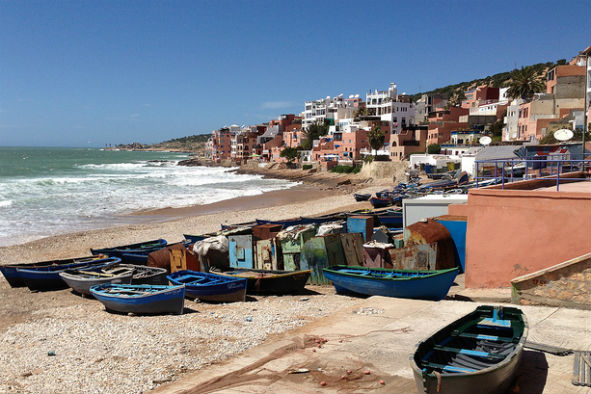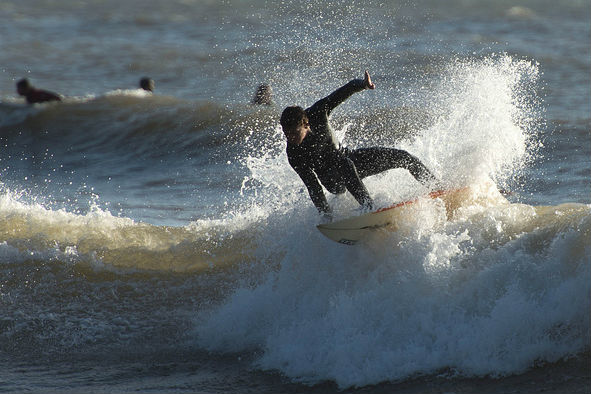Discover another side of Morocco in Taghazout, a quaint fishing village in the Souss-Massa Draa region that offers respite from the chaos of the northern cities. A thriving surf-culture stems from an influx of hippies in the 1960’s, and continues to draw in those looking for golden waves on the Moroccan coast.

Blue fishing boats in Taghazout, Morocco. (Photo: heather Cowprer via Flickr)
Escape from the City
Surfboards wedged under our arms, we hitch-hiked back to town on the back of a livestock truck, a warm breeze whipping the sand from our hair. The sun was still hot and it gradually sank into the sea, painting the landscape with streaks of gold. Squinting my eyes against the wind as we meandered along a quiet road between desert and beach, I could still smell the ocean.
We had pulled up to the place we would call home earlier, too exhausted to fully appreciate the quiet charm of the sleepy fishing village, having spent nearly four hours squashed into a taxi negotiating the coast from Essaouira down to Taghazout. And when I say squashed, I mean really squashed, each with our own sizeable luggage in a game of human and rucksack tetris. Aside from a number of minor hiccups – running out of petrol a few kilometres into the drive, veering into the path of many an oncoming truck – we had settled into the journey, and each other, anticipating the first sight of the sea with every twist of the wheel.
After hours of numbed limbs and bizarre sights – including a goat perched in a tree – we drew into Taghazout. Beloved by hippies in the 60’s and 70’s, this Berber fishing village was originally used as a place to store fishing equipment. Leaving an honest, agricultural past behind it, Taghazout has since become a renowned surfing destination, loved for its an old-world feel. Once upon a time, the village was fought over by the Amazigh tribes, and as we stepped out of the vehicles, we began to understand why. Giddy with the freedom of unfolding our bodies, it was a pleasant surprise to touch down in a place so wildly contrasting to the city we had left behind.
The change in smell was the first thing I noticed. In the cities an overwhelming array of spices, animals, food, dust and dirt clung stubbornly to my nostrils. Here, I sucked fresh sea into my lungs. Sun bleached buildings were stacked against the shoreline with goats scattered throughout; in and out of doorways, across roads, up stairs. Essaouira had been fantastically loud; an overwhelming concoction of voices calling out to each other, motorbikes screaming through narrow streets and music from the numerous bars and restaurants. In Taghazout, I could hear nothing but the occasional car, the sea, the chatter of passers-by and the consistent bleating of goats.
Travelling from Marrakech to Fez to Essaouira, we had thrown ourselves willingly into the heart of the cities. Hours were spent getting lost in Medinas and immersing ourselves in a whirling mixture of colour, noise, smell, taste, and a pace of life so contrary to the laid-back atmosphere of Taghazout. Here, I felt we had discovered a quieter, low-key way of life.
Surf’s Up on the West Coast
All along the coastline that stretches from Essaouira to Agadir, there are hotspots with waves to cater to every ability. For seasoned pros, spots such as ‘Killers’ (which, as the name suggests, puts up a fight) are reachable in a 20-minute paddle that rewards with fast barrelling waves. For those less inclined to go to such lengths, the more forgiving Banana Point and Panoramas sit further south. Although good year-round, the best waves hit the shore between December and the end of February.
With the year round average temperature rarely dropping below 10°C in Morocco, our September visit didn’t necessitate wetsuits. Used to braving the British coast in winter, this was something of a treat. On our first full day in Taghazout, we grabbed our boards and caught a local bus down to Banana Beach, facing a few disgruntled looks as we awkwardly shuffled between rows with our hefty boards.
The waves at Banana Beach provided us with a welcome playground, with consistent rolling sets peeling in from the point break. Days of sunshine, salt-streaked cheeks and aching muscles stretched ahead. All around us, the bright blue sky reflected on the still surface and we floated alone, with nothing clouding our minds but the hunt for a decent wave.

Taghazout Surfing. (B.Bank via Flickr)
Getting There
Those that make the pilgrimage west tend to seek an adventure cast off from the standard tourist trail. Taghazout is easily accessible from one of the largest souks in Africa, situated at the centre of Agadir, and not far from the vast palm groves and river gorges of Paradise Valley leading to the Atlas mountains. Within reach of traditional Moroccan baths in Banana Village, there’s plenty of opportunity to soothe tired bodies post-surf.
To get a full package that includes hire, transportation, surf lessons, yoga, food and accommodation, stay with Surf Berbere. Situated right on Hash Point and offering a variety of packages to suit all requirements for old hands or new starters. For a smaller homestay experience there is Ocean Surf House, offering two traditional Moroccan apartments, outstanding views of the waves, and rumours of a wicked tagine. If you just need somewhere to simply rest your head and your surfboard, Surf Taghazout offers a bed and breakfast package. For complete independence you can hire from rentasurfboard and stay in one of the many self-catered apartments in Taghazout.
It should also be noted that there is no alcohol for sale in Taghazout, so those who require après-surf will need to buy ahead or travel to Agadir. Nevertheless, it’s the perfect excuse to detox, made easy with the flurry of locally caught fresh fish on offer, endless waves to surf, and the setting of a moment of calm in the midst of a fascinating country.